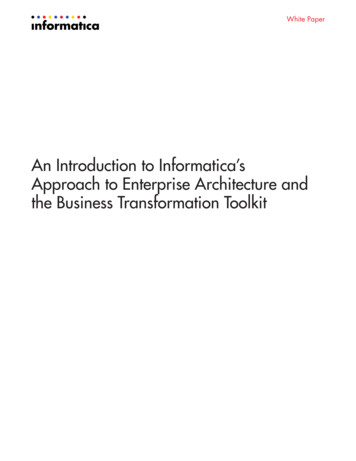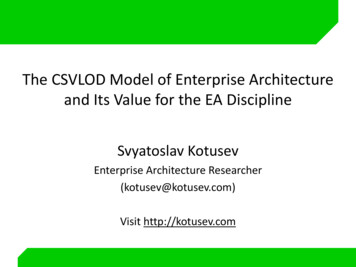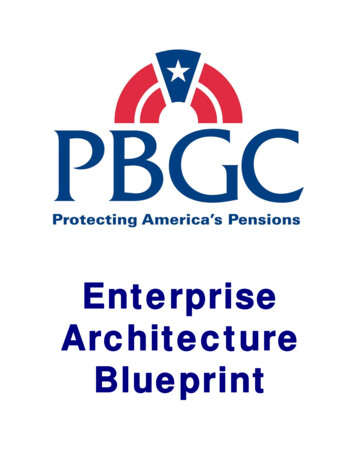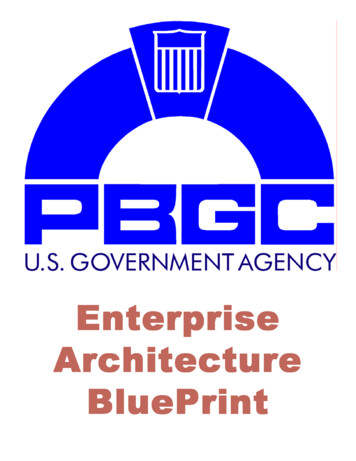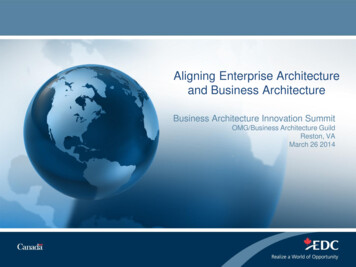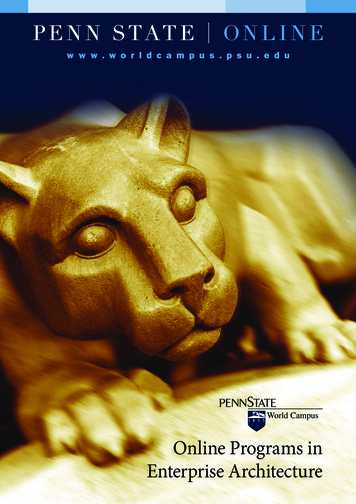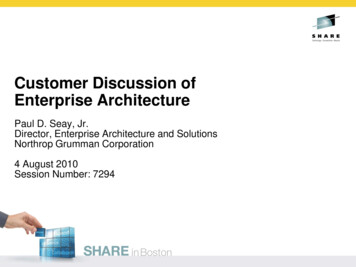
Transcription
Customer Discussion ofEnterprise ArchitecturePaul D. Seay, Jr.Director, Enterprise Architecture and SolutionsNorthrop Grumman Corporation4 August 2010Session Number: 7294
Discussion Topics Enterprise Architecture (EA) OverviewEA Organizational MaturityGuiding PrinciplesTechnical Reference ModelArchitecture Solution PatternsStrategies and RoadmapsPattern-Based Strategies2
Enterprise Architecture (EA) OverviewThe Definitions Gartner –“Enterprise architecture is the process of translating business vision and strategy into effectiveenterprise change by creating, communicating and improving the key principles and models thatdescribe the enterprise„s future state and enable its evolution.” IBM –“The Enterprise Architecture discipline defines and maintains the architecture models, governance,and transition initiatives needed to effectively co-ordinate semi-autonomous groups towards commonbusiness and/or IT goals” Open Group –“Enterprise architecture is the description of an enterprise as a system in terms of its components,their inter-relationships, and principles and guidelines governing the design and its evolution.3
Enterprise Architecture (EA) OverviewEarly HistoryThe cost involved and the success of the business depending increasingly on its informationsystems require a disciplined approach to the management of those systems.IBM Systems Journal“A Framework for Information Systems Architecture”J. A. Zachman4
Controlling (Organization of “No”) versus Enabling (“This is How”)Enterprise Architecture MaturityCEO Level BusinessGovernanceCIO LevelIT Governance BoardCTO Level TargetedStrategies and RoadmapsTransformation toPortfolio CentricityEA OrganizationStandards and ControlTransformation toApplication CentricityVariety vs. VariabilityTaxonomy and InventoryTechnical Focus versus Business Focus5
Guiding Principles (Sample Set) Business Drives IT Architecture DecisionsArchitecture Is a “Living” Entity: Define and periodically refineReengineer Business and IT TogetherArchitecture Enforcement: Architecture decisions with a governance organizationIndustry Proven TechnologyVendor/Open Neutral StandardsSolutions Preference: (1) use existing applications; (2) COTS; (3) new customapplications; etc.Secure Information Access: Enterprise Architecture must provide appropriateprotection of information and infrastructure components.Reduce Integration Complexity: Keep it simple. Controlled variability; proper variety.Uniformity in Design: Enterprise Strategy and Architecture, Systems Engineering,Systems Development, and Operational Delivery organizations act as one businessenabling unit.6
ApplicationsSecuritySystems ManagementData, Information andKnowledge AccessIntegration and InteroperabilityPlatformsStorageApplication DevelopmentTechnical Reference Model(Sample High Level 1)Networks7
CollaborationDatabase ManagementSystemsData Administrationand UtilitiesERPCRMEngineering ManagementBusiness Intelligence &Data WarehousingSCMProject t DeliveryE-LearningPersonal ProductivitySoftwareIntegration ngeServicesHandheld &MobileDocument &ImagingHardwareStorageComponentsSystem DiskStorageSystemsSystem ical LayerData Link LayerNetwork LayerTransport LayerWANVoice ServicesVideo ServicesData ServicesApplication ArchitectureKnowledgeManagementApplication DevelopmentTechnologies and ToolsIdentityManagementDirectoryServicesIntegrity &ConfidentialityPerimeterDefense &AnalysisIT Resource MgmtEnterprise Job MgmtConfiguration MgmtOutput MgmtAvailability &Performance MgmtService MgmtTechnical Reference Model(Sample Detail Level 2)8
Architecture Solution PatternsThick-Client Functionality Example9
IT Strategies “Pounds of Paper” Do Not Make a Better Strategy Base Everything on Your “Laws” (Guiding Principles) Focus on the Business Strategy Derive the Business ProcessesAlign the Information Architecture to the Business ProcessesExtrapolate to the Required Applications ArchitectureDetermine the Supporting Infrastructure Strategy10
Business Focused IT Roadmaps Strategic RoadmapsMission enabling strategic roadmaps directly reflect the business strategy to reach avisionary operational state for improved effectiveness. The investment cycle for missioncapability roadmaps take into consideration the operational environment’s AS-IS stateand define a pathway through achievable milestones and release spirals to drive to aTO-BE state, usually 3 to 5 years in the future. Supplier Driven RoadmapsSupplier driven roadmaps manage and plan the tactical adoption of technology providerimprovements, represent the life-cycle and sunset timeline for products reaching theirend-of-life or retirement, inform in order to avoid unsupported product situations, identifythe interdependencies of integrated product solutions in relation to their capabilities, andaid in the process for just-in-time investment and product adoption to maximize missionbenefits.11
Supplier Driven RoadmapExampleProductSupplierAvailabilityEntry edSupportRetiredSunset DateS S S S S S S S S S S S S SS S S S S S S S S S S S S S8/30/20033/15/2009N/A11/1/201011/1/2010S S S S S S S S S S S S S S S S S S S S S S S -JunJul-DecJan-JunJul-DecOperating SystemMicrosoft Windows XP Professional BaseMicrosoft Windows XP Professional SP3Microsoft Windows XP Tablet PC Edition BaseMicrosoft Windows XP Tablet PC Edition /20082/11/20038/30/20038/1/200412/1/2004S S S S S S S S S S S S S S S S S S S S S S S 20146/30/2014S S S S S S S S S S S S S S S SS S S S S S S S S S S S S S S SP P P P P P E E E E E E E E E EP PP P P P P P E E E E E E E E E EP 0Microsoft Windows XP Tablet PC Edition SP2Microsoft Windows XP Professional x64 SP2Microsoft Windows 7 x32 EnterpriseMicrosoft Windows 7 x32 Enterprise SP1Microsoft Windows 7 x64 EnterpriseMicrosoft Windows 7 x64 Enterprise EN/A11/1/20081/1/201012
Pattern-Based Strategies Enterprise Architecture Reflects the Business Strategy Pattern-Based Strategies: Latest Maturity Level in theBusiness Strategy and Enterprise Architecture Model Business Ecosystem Driven Strategy Sense the Ecosystem Around Your Business Consider the Global EcosystemThink “Far Outside the Box”Understand the Broader Context of Competitive PressuresReflect on the Implications Examples Twitter – What Implications Exist for Sales?13
IT Shapes theBusiness Today14
Questions?15
Enterprise Architecture (EA) Overview The Definitions Gartner - "Enterprise architecture is the process of translating business vision and strategy into effective enterprise change by creating, communicating and improving the key principles and models that describe the enterprise„s future state and enable its evolution." IBM -

